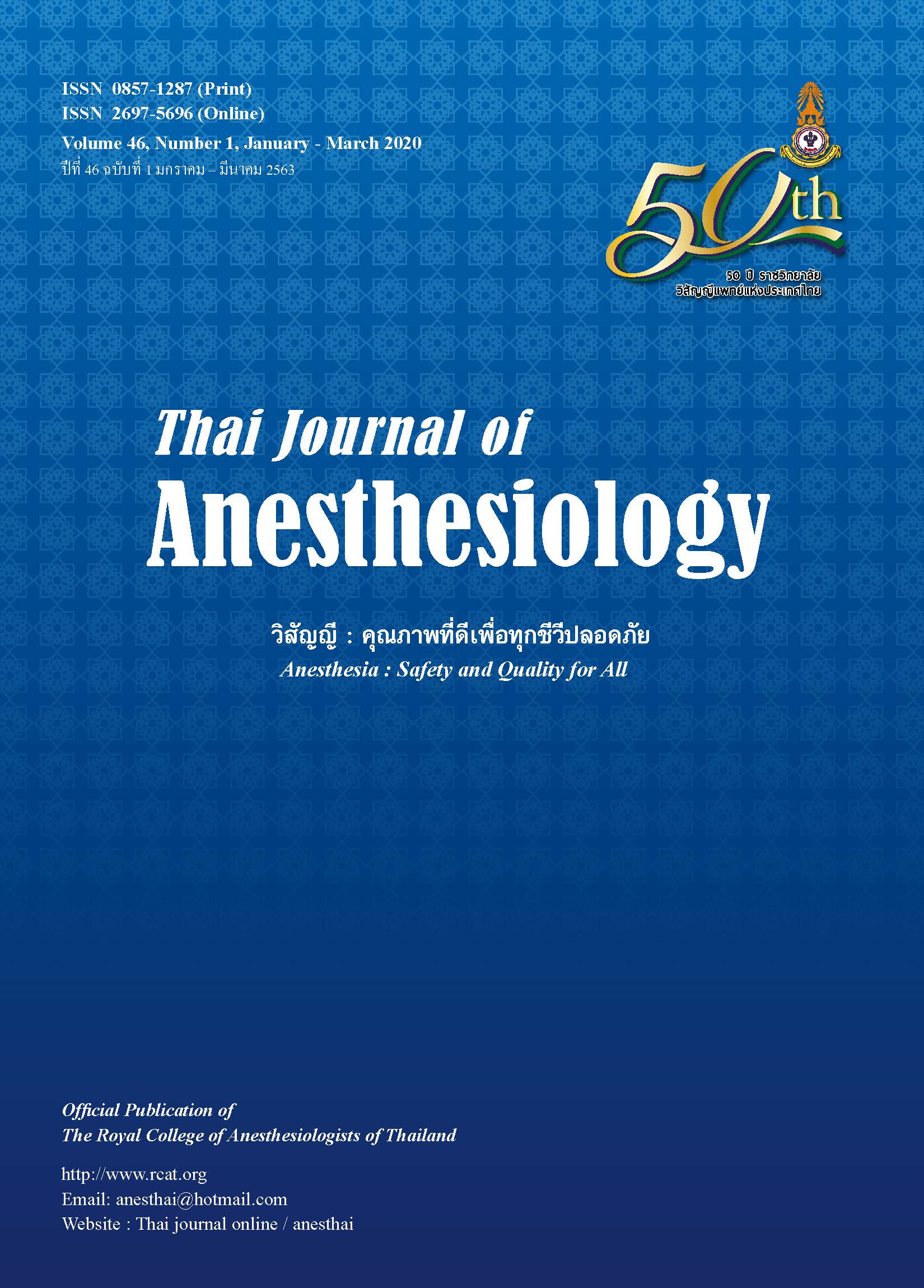Very Low Concentration Levobupivacaine Femoral Nerve Catheter Infusion for Postoperative Pain Management in Total Knee Replacement in Combination with 0.1 mg Spinal Morphine
Main Article Content
Abstract
Background: Post total knee replacement pain is
categorized as moderate to severe pain. Well management
of postoperative pain will enhance patient recovery. The
study aims to compare between 0.04% levobupivacaine
for femoral nerve catheter in combination with 0.1 milligram
intrathecal morphine with only 0.1% levobupivacaine for
femoral nerve catheter.
Methods: An experimental study, double blinded,
randomized-controlled trial was conducted in total knee
replacement.
Pateints in LBM group received 0.04% levobupivacaine
combined with 0.1 milligram intrathecal morphine, BM
group received only 0.1% levobupivacaine for femoral
nerve catheter for 48 hours after surgery. Postoperative
pain scores were assessed at 6, 12, 24, 48 hours.
Morphine consumption, nausea-vomiting, itchiness and
muscle weakness of the legs were also assessed.
Results: There were 46 patients included in the study.
Pain scores at rest and while movement at 6 hours were
significant lower in LBM group (3.88 vs 1.61, p=0.005),
(5.88 vs 3.39, p=0.02). However, at 12 hours only
movement pain was lower in LBM group (5.33 vs 4.42,
p=0.034). Muscle weakness of the legs was significant
lower in LBM group (Bromage I 29.4% vs 69.4%,
p=0.028). There was no different on intravenous morphine
consumption, nausea-vomiting and itchiness.
Conclusion: Combined continuous femoral nerve block
catheter with 0.04% levobupivacaine with 0.1 milligram
intrathecal morphine provides effective pain control for
total knee replacement.
Article Details
References
morphine for postoperative analgesia: a randomized,
controlled, dose-ranging study after hip and knee
arthroplasty. Anesth Analg 2003;97:1452-7.
2. Millar WJ: Hip and knee replacement. Health Rep 2002;14:
37-50.
3. Allen RS, Thorn BE, Fisher SE, et al. Prescription and dosage
of analgesic medication in relation to resident behaviors in
the nursing home. J Am Geriatr Soc 2003;51:534-8.
4. Arpino L, Iavarone A, Parlato C, Moraci A. Prognostic role of
depression after lumbar disc surgery. Neurol Sci 2004;25:
145-7.
5. Lang SA: Postoperative analgesia following total knee
arthroplasty: A study comparing spinal anesthesia and
combined sciatic femoral 3-in-1 block. (Letter) Reg Anesth
Pain Med 1999;24:97.
6. Choi P, Bhandhari M, Scott K, Douketis JD: Epidural
analgesia for pain relief following hip or knee replacement.
Cochrane Database of Systemic Reviews 2003;3:CD003071.
7. Bailey PL, Rhondeau S, Schafer PG, et al. Dose response
pharmacology of intrathecal morphine in human volunteers.
Anesthesiology 1993;79:49-59.
8. Cousins MJ, Mather LE. Intrathecal and epidural
administration of opioids. Anesthesiology 1984;61:276-310.
9. Gehling M, Tryba M. Risk and side effects of intrathecal
morphine combined with spinal anaesthesia: a metaanalgesia.
Anaesthesia 2009:64:643-651.
10. Buvanendran A, Tuman KJ, McCoy DD, Matusic B, Chelly
JE: Anesthetic techniques for minimally invasive total knee
arthroplasty. J Knee Surg 2006;19:133-6.
11. Bauer M, Wang L, Onibonoje OK, et al. Continuous femoral
nerve blocks: decreasing local anesthetic concentration to
minimize Quadriceps Femoris weakness. Anesthesiology
2012;116:665-72.
12. Pelt CE, Anderson AW, Anderson MB, Van Dine C, Peters
CL. Postoperative falls after total knee arthroplasty in patients
with a femoral nerve catheter: Can we reduce the incidence?
J Arthroplasty 2014;14:18-7.
13. Widmer B, Lustig S, Scholes CJ, Molloy A, Leo SP, Coolican
MR, Parker DA. Incidence and severity of complications due
to femoral nerve blocks performed for knee surgery. Knee
2013;20:181-5.
14. Capdevila X, Barthelet Y, Biboulet P, Ryckwaert Y,
Rubenovitch J, d’Athis F. Effects of perioperative analgesic
technique on the surgical outcome and duration of
rehabilitation after major knee surgery. Anesthesiology 1999;
91:8-15.
15. Richman JM, Liu SS, Courpas G, et al. Does continuous
peripheral nerve block provide superior pain control to
opioids? A meta-analysis. Anesth Analg 2006;102:248-57.
16. Wasserstein D, Farlinger C, Brull R, Mahomed N, Gandhi R.
Advanced age, obesity and continuous femoral nerve
blockade are independent risk factors for inpatient falls after
primary total knee arthroplasty. J Arthroplasty 2013;28:1121-4.
17. Gerbershagen HJ. Pain intensity on the first day after surgery.
Anesthesiology 2013;118:934-44.
18. Rathmell JP, Pino CA, Taylor R, Patrin T, Viani BA. Intrathecal
morphine for postoperative analgesia: a randomized
controlled, dose-randing study after hip and knee
arthroplasty. Anesth Analg 2003;97:1452-7.
19. Ackerman DB, Trousdale RT, Bieber P, Henely J, Pagnano
MW, Berry DJ. Postoperative patient falls on an orthopedic
inpatient unit. J Arthroplasty 2010;25:10-14.

